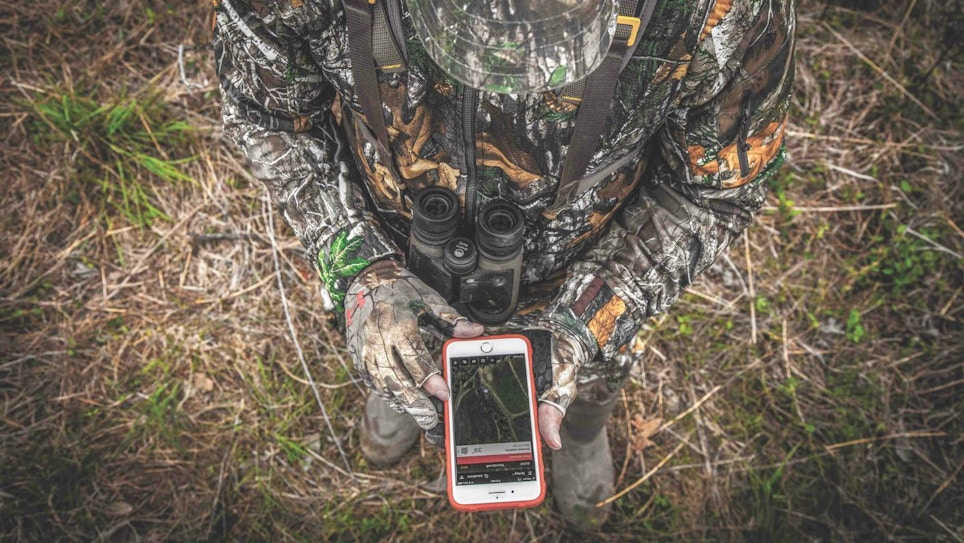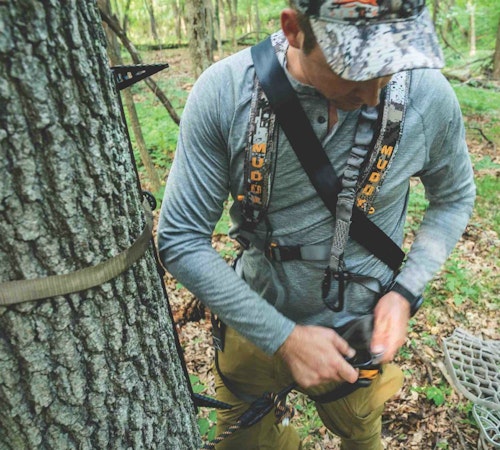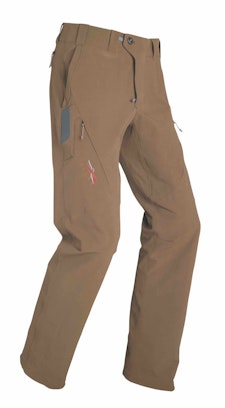
One of the author’s favorite smartphone apps for quickly learning whitetail terrain is ScoutLook Hunting.
I believe we can all agree that scouting affects whitetail-hunting success. When travel to a hunting location is required, it can affect it even more. If you’re lucky, you may get an additional day or two to find productive stand locations and hang stands from which to hunt the remainder of your stay.
All of this means that, despite limited scouting time, you must make virtually no impact or disturbance. Otherwise, your hunt could take an unproductive turn.
Whether it’s on the other side of my state or out-of-state, I approach foreign ground whitetail hunts with what I call, “speed scouting.” I’m not claiming my way methodical approach is best, but it has worked well for me, and I believe it can for you, too. Let’s review its basics.
Pre-Hunt Mapping
It’s not enough to get a public land atlas from a state wildlife department and then highlight a few parcels to try out when you arrive. No, that’s only the beginning.
After pegging parcels of interest, I scour both topo and aerial maps to identify places to focus on and narrow down potential stand locations. You cannot afford to waste time during your hunt. Preliminary mapwork puts you in productive scouting locations when you arrive. Successful hunters have been doing this for years and it works.
Smartphone apps are priceless both before and during your hunt. I recommend either onX Hunt or ScoutLook Hunting — I have both. Each denotes land ownership so you can identify property borders clearly. Both also have aerial and topographical base maps. These features and many more can help you scout faster and more tactically without disrupting obvious bedding areas or hiking through unproductive areas. It’s a constant reference with pocket convenience. Remember, the clock is ticking, and you must scout quickly, but with little to no impact.
Cautious Footsteps
Nothing tells the story like on-foot scouting. You can pour over maps endlessly, but until you burn some boot rubber, questions will linger. Caution: Don’t run ragged; make every step count. One false move could blow your entire week.
When time is limited, we tend to rush. Yes, my article title is “Speed Scouting,” but that has little to do with your walking speed. By speed scouting, I mean you have one or two days, and how you use them matters. Sure, hustle can be a good thing in certain instances, but don’t get moving so fast that you go places you shouldn’t or miss important details.
First, don’t hike into areas with the wind at your back. Doing so may carry your scent to a bedding area. No, you’re not traipsing through the bedding area, but you’re alerting deer to human presence in a specific location. Thus, even a great stand location could turn cold because of a simple oversight.
Let’s discuss another scent-related mistake: wearing odor-ridden street clothes while scouting. You wouldn’t hunt in those clothes, so don’t scout in them either. Every bit of vegetation they contact will remain contaminated and detectable to a whitetail’s nose for several hours.
For that reason, dedicate a couple sets of clothing for scouting. Wash them in odor-eliminating laundry detergent and store them in an airtight tote. Change into them once you’ve parked your vehicle at the property. Spray them down with odor-eliminating spray, and spray your hands and face. The goal is to leave as few traces of your scent as possible while you scout.

Lastly, I’ve walked with enough folks to know that many scout complacently. They make excessive noise by talking loudly or tromping through leaves and breaking sticks. Tactical scouters are consistently more successful than those who blunder about. Minimize commotion and avoid unnatural sounds like metal-on-metal or speaking loudly.
Now that we’ve discussed how I scout and mistakes to avoid, let me share what I look for while speed scouting.
Read the Sign
Deer congregate every evening at food sources, which explains the concentrations of sign in them. However, experience has proven that these are rarely good places to hang stands, especially on public land. Why? Because mature bucks most often visit them in the dark, plus you’ll probably have competition. Sign and ease of access are alluring. However, a better bet is usually to get away from fields and hunt terrain.
Deer sign is less valuable than you might think. One example is an Oklahoma funnel I found on a recent trip. I’d scouted a sign-littered soybean field. My trail camera revealed one shooter buck and a few youngsters well beyond legal shooting time, as well as a bird hunter. Time for Plan B.
I hiked off the field until I found a pinch point where multiple terrain features intersected. Again, the area had minimal deer sign compared to the soybean field, but here my odds of A) getting an archery-range shot and B) encountering a shooter during daylight were more likely. My first sit confirmed my suspicions; the funnel with minimal deer sign yielded a 150-class buck.
Finger On the Pulse
Sometimes things in a given area just don’t add up to one or two killer stand locations. Perhaps it lacks terrain features, or maybe you haven’t pushed deep enough, which is better than pushing too deep too quickly and creating major impact.
In either case, it makes solid sense to hang and hunt an observation setup with great visibility of the fringe of a given area. It’s a low-impact effort that can put your finger on the pulse of deer movement in the area. From observation stands, I’ve killed one mature buck, seen many more and almost killed a giant non-typical.
Your observation hunt has three potential outcomes: you kill a buck, you see bucks in the distance and now know where to hunt the following day, or you are skunked and determine that you must push deeper and scout for a more productive location. In my eyes, all three outcomes are productive.
Finding a stand location from which to harvest a buck within 2 days isn’t easy, especially on unfamiliar ground. How you scout could either botch your chances to kill a buck or increase them. If you follow the speed-scouting tips outlined above, you probably won’t kill a dandy buck on every traveling bowhunt, but I bet you’ll have hunts that are more productive.
Sidebar: Scouting Apparel
It’s important to reserve apparel — washed in odor-eliminating detergent and stored in an airtight tote — specifically for scouting and hanging treestands. Sitka Gear has some solid options for these applications.
The Hanger Henley ($79) is a lightweight and breathable 3-button Henley treated with Insect Shield and Polygiene to control mosquitoes and reduce odor production. Comfortable stretch material dries quickly to manage moisture caused by perspiration or precipitation.
Articulated patterning and four-way-stretch nylon materials on the Grinder Pant ($189; left) promote mobility for scouting and hanging stands. Because dew or rainfall often coats vegetation during scouting missions, the water-repellent DWR finish is the answer. Diagonal thigh pockets provide storage for small items or ventilation as temperatures rise.
CONTACT: www.sitkagear.com






